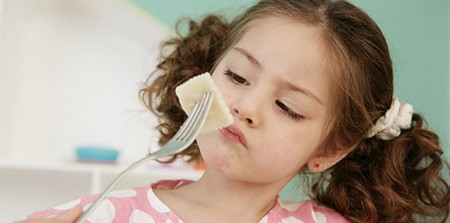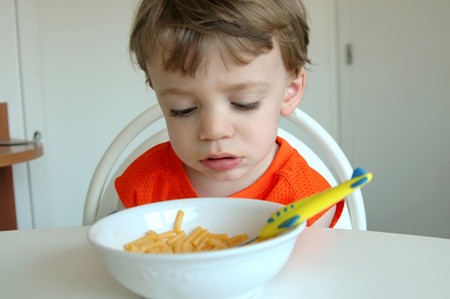By the end of the first year, your child should be eating mainly family meals, although prepared with less salt or sugar than for an adult. She will bite and chew with her gums a long time before teeth appear, using the copious saliva she also produces to help soften foods. In fact, chewing and biting with the gums helps to promote the proper alignment of teeth as they come through.
By now you will be offering your toddler food that needs to be chewed, even if it is often chopped up in small, bite-sized pieces. In addition, offer soft foods from which she can take a bite; for example, pieces of banana.
- Introduce new foods one by one to make certain your toddler is not allergic to them.
- Certain food items are best avoided, as they run the risk of choking – peanuts, whole grapes, boiled sweets, large pieces of raw carrot, for example.
- Never leave a toddler who is eating unattended, and never allow her to eat while on the move.
Feeding herself
You can probably expect your toddler to feed herself with finger foods pretty well by now, and this will improve dramatically over the year as her hand-eye skills and her coordination and dexterity improve. She may be quite slow, especially to start with, and is unlikely to sit down and just eat – sometimes preferring to play with her food! – but, even if haphazard, using a spoon competently is possible at this age. You may need to help her finish off what’s in her bowl, or feed her the occasional spoonful as she feeds herself, but by and large she should be able to manage by herself.
Providing foods that can be eaten by hand – pieces of fruit, or little sandwiches, for example – also helps her feel that she is becoming more independent and that should please her and make her want to eat, too.
Balancing liquids and solids
In addition to being able to feed herself your child should be drinking regularly from a cup – even if you start with a feeder beaker. Bottles should now be a thing of the past, and if you are still breast-feeding this may be limited now to morning and evening feeds.
If your child is slill having large quantities of milk during the day, which helps her feel “full up” very quickly, she may not develop enough of an appetite for her meals. At this age two to three glasses of whole milk per day is more than enough. She may prefer drinking milk to eating solids, which is more time-consuming and less immediately satisfying in terms of feeling full. Encourage her to concentrate on solids at mealtimes and offer her some milk after she has eaten.
Drinking large quantities of juice can have a similar effect, especially as the sugar content in fruit juice is high. It may also cause diarrhoea and will increase the risk of tooth cavities. Drinking a lot of fruit juice now will give your toddler the expectation of high-sugar foods later on. Limit her intake to100g(4oz) a day. One very effective way of doing this is to dilute her drinks of fruit juice with water.
Eating together
When it comes to helping your toddler see what is expected of her at mealtimes, it helps if you sit and eat together, perhaps not at every meal but certainly once a day, at this age it is through imitation, and imitating the behaviour of those close to her that your child is learning about her world and what happens in it.
Sitting together over a meal is a great time for family interaction and starting a routine, It also provides your toddler with the opportunity to learn how to behave appropriately at the table by imitating other members of the family. If you don’t do this at home, it will be difficult for her to know how to do it if you go out to a relative’s or a restaurant. And, while you cannot expect a toddler to tolerate a three-course, sit-down meal, you can help her join in and eat, and spend some of that time ill the table contributing to the social occasion of the meal and family interaction.
Categories
Advertisements
Recent Articles
 How to Understand Bed Sizes – A Small Guide
How to Understand Bed Sizes – A Small Guide How to Select Some Must Have Kitchen Accessories
How to Select Some Must Have Kitchen Accessories Best Way to Change a Car Tire
Best Way to Change a Car Tire Best Way to Write an Affirmation
Best Way to Write an Affirmation Best Way to Take Charge of Your Financial Life
Best Way to Take Charge of Your Financial Life Best Way to Survive a Party When You Don’t Know Anyone
Best Way to Survive a Party When You Don’t Know Anyone Best Way to Stop Self Sabotaging Yourself
Best Way to Stop Self Sabotaging Yourself Best Way to Start Journal Writing
Best Way to Start Journal Writing Best Way to Speak with a Powerful Voice
Best Way to Speak with a Powerful Voice Best Way to Simplify Your Life
Best Way to Simplify Your Life Best Way to Respond to a Put-Down
Best Way to Respond to a Put-Down Best Way to Reduce Acne Breakouts
Best Way to Reduce Acne Breakouts Best Way to Recover from Dining Disasters
Best Way to Recover from Dining Disasters Best Way to Quit Your Job Gracefully
Best Way to Quit Your Job Gracefully Best Way to Make Your Own Website
Best Way to Make Your Own Website



Leave a Reply